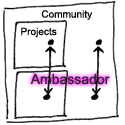 Ecma, the vendor-driven standards body that used to be the European Computer Manufacturers Association, has rubber-stamped Microsoft’s next-generation document file formats, called Office Open XML. Ecma’s vote places Office Open XML onto the fast track toward ISO recognition.
Ecma, the vendor-driven standards body that used to be the European Computer Manufacturers Association, has rubber-stamped Microsoft’s next-generation document file formats, called Office Open XML. Ecma’s vote places Office Open XML onto the fast track toward ISO recognition.
I haven’t delved into the 6,039-page specification itself, so I can’t comment on the technical quality of the Office Open XML spec. However, I am troubled about the licensing issue, and of course the competitive aspects of turning one company’s impossible-to-implement spec into an industry standard. (You can download the spec, now called Ecma-376, as a 47MB PDF document.)
Office Open XML is a Microsoft format. Microsoft has not surrendered its intellectual property, but has instead issued what it calls a “Covenant Not To Sue.”
An agreement by a company not to sue people over its patents shouldn’t be the basis of an industry standard, ticularly one with there’s the potential for lock-in or other shenanigans. If it were truly interested in standard, it would have released the intellectual property in the specification into the public domain, vs. kept it as part of its IP pool.
You can look at this in one of two ways: Either Microsoft believe that Office Open XML will secure its Office monopoly, or Microsoft believes that Office Open XML is a threat to that monopoly. It’s unlikely that Microsoft would have submitted specifications that would be a threat to its monopoly. So, therefore…
The real goal of Office Open XML is to give Office an imprimatur that it requires for meeting some governmental contract guidelines: that file formats be non-proprietary. Those regulations, widely supported by everyone but Microsoft, are driving governments to use products that support the OASIS Open Document Format for Office Applications, ISO/IEC 26300:2006, also known as OpenDocument or ODF.
Microsoft could adopt OpenDocument, but then it would lose control over the file format – the key weapon used ensure customer lock-in. Therefore, Microsoft proposed its own competing XML-based file format, Office Open XML, based on the XML schemas that it was already using to successfully lock competitors out of Office, and of course made sure that the specification would be impossible to implement by anyone who didn’t already have the Office source code. 6,039 pages!
Thanks to Ecma (and soon, the ISO, one presumes), Office Open XML will be a de jure standard, and Microsoft will be able to go back after the government business that it’s losing to OpenDocument-based tools. Because it is unlikely that anyone but Microsoft will ever be able to fully implement Office Open XML in a 100% compatible fashion, lock-in will retained.
It’s realistic to expect that competitors will only be able to implement subsets of Office Open XML — and customers will measure competitor’s implementations against their compatibility with Microsoft’s implementation. In fact, I wouldn’t be surprised if Microsoft tries to get future government bids written to require 100% implementation of Office Open XML.
They shoot, they score.
(The Wikipedia offers a technical comparison of Office Open XML and OpenDocument. I can’t vouch for its accuracy.)
Microsoft’s Brian Johnson blogs about his company’s joyous reaction to Ecma’s approval of Office Open XML. IBM’s Bob Sutor, who has led the opposition to Office Open XML, offers his own commentary, and IBM’s Rob Weir explains why IBM was the only company to vote against approval of Office Open XML.
Z Trek Copyright (c) Alan Zeichick
 I love the cover of the January 2007 issue of Software Test & Performance. It has graphics by LuAnn Palazzo, the wonderful art director for that magazine, and text from Edward Correia, the editor of ST&P. Be sure to read the fine print on the can.
I love the cover of the January 2007 issue of Software Test & Performance. It has graphics by LuAnn Palazzo, the wonderful art director for that magazine, and text from Edward Correia, the editor of ST&P. Be sure to read the fine print on the can.




























